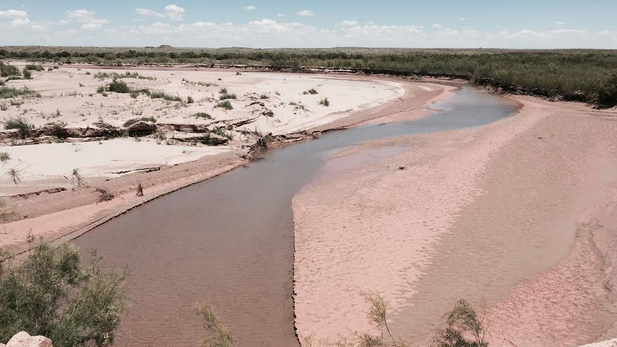 Atop the Winslow levee on the Little Colorado River in Navajo County.
Atop the Winslow levee on the Little Colorado River in Navajo County.Listen:
By Will Stone, Fronteras Desk
County and city governments in Arizona are wrapping up budget season for the fiscal year that starts next week, and some are struggling with the Legislature’s pass-along cuts to local governments.
One example is in northeastern Arizona's Navajo County, where an aging levee on the muddy banks of the Little Colorado River is out of federal compliance and in need of expensive repair.
“There’s a bunch of ways that the levee can fail, and I would just hate to see the dwellings under water, said Navajo County engineer Bryan Cook.
Cook knows. In 1993, the levee failed, and more than 100 homes in Winslow were flooded.
“It was decertified in 2008 by FEMA for not meeting the requirements of a levee,” he said.
That’s why the county and Army Corps of Engineers are planning a multimillion dollar reconstruction project. But what seemed financially viable has hit a roadblock.
“We are looking at taking almost $1 million out of county flood control district to help mitigate the impacts of the state Legislature on Navajo County,” County Manager Jimmy Jayne said.
The county is having to cover an additional $750,000 as a result of the state budget, costs that the state had covered. It has meant raiding the tax dollars set aside for the levee.
“The governor and the Legislature haven’t actually balanced the state budget," Jayne said. "They simply shifted costs to local governments, largely counties in Arizona.”
He said nearly 80 percent of the county's revenue from property taxes goes right back to the state.
Other counties are in a similar position, said Brad Carlyon, Navajo County attorney and president of the Arizona Association of Counties Board.
“With a certain segment of the Legislature, they’re so focused on getting smaller government," Carlyon said. "They see this as a way to force smaller government on counties and municipalities because they know that we do not have the tools to increase our revenue.”
During the recession, Carlyon said, they became more efficient, but there’s nowhere else to cut. He has lost seven lawyers from his office, which has a host of constitutionally mandated services.
Legislators and taxpayer advocates said a broader perspective is in order.
“The great recession’s impact on the state general fund was significantly higher than it was on local government," said Kevin McCarthy, with the Arizona Tax Research Association. "The state lost almost 40 percent of its revenue through the recession. You didn’t see that at the county level.”
That’s because counties get most of their revenue from property taxes, not sales or income. McCarthy was critical of counties for siphoning tax dollars collected for another purpose.
“They lean on some of these other revenues sources because politically it is easier for them to do than coming out and saying the state has shifted X amount to us," he said, "and we are going to raise property taxes to make up f or that and have a very open and transparent dialogue with their taxpayers.”
McCarthy cited Maricopa County as an example, because it is preparing to raise taxes. Pima County is doing the same, unless its lawsuit against the state for an $18 million shift is successful.
Tax increases are not possible in Navajo County, which is at its state limit for taxation.
Republican state Sen. Sylvia Allen, who represents much of Navajo County, said government spending should be as lean as possible.
“We have taken on so many responsibilities," Allen said. "I look at counties. What is the constitutional thing counties should do? And that’s provide for law enforcement and for roads.”
Allen said she doesn’t agree with all the cost shifts, such as the loss in funding for highways and counties’ obligation to pay for sexually violent offenders and juvenile detention.
That's Navajo County Attorney Brady Carlyon said he is worried about a nearing crisis.
“We’ve tried to protect law enforcement and the sheriff’s office, same within our jails because one it’s a huge liability," he said. "Two it’s life. But you know we’ve cut everybody else. We’ve got to start going there next, and we can’t afford to go there next.”

By submitting your comments, you hereby give AZPM the right to post your comments and potentially use them in any other form of media operated by this institution.